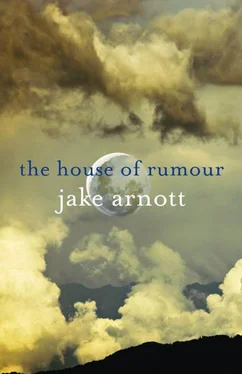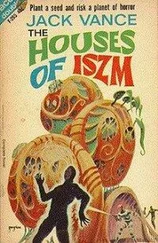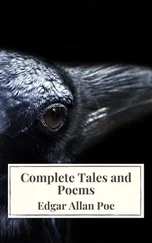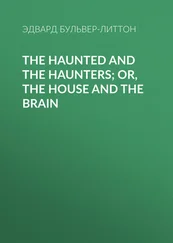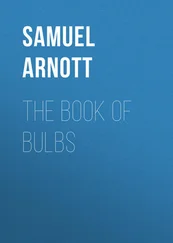Jake Arnott
THE HOUSE OF RUMOUR
At the middle of the world, between earth, sea and sky, a point where all three regions of the universe join, there is a place from which all that exists can be seen, no matter how distant, and every voice heard by listening ears. Here Rumour lives, in a high tower she has chosen for herself, with innumerable avenues and thousands of entrances that are never closed. Open night and day, her house is built of sounding bronze that hums and echoes, repeating all it hears. There is no rest within, no silence in any room, but no clamour neither, only the murmur of voices, like the sea’s waves heard from afar, or the last tremors of thunder after Jupiter has clashed storm-dark clouds together.
Crowds occupy the hallways, a fickle throng that come and go with myriad rumours, circulating confused words, fiction mixed with truth. Some fill idle ears with gossip, others pass on stories, each consecutive narrator adding some new detail to the telling. This is the haunt of Credulity, rash Error, empty Joy and unreasoning Fear, impulsive Sedition and Whisperings of Doubtful Origin. Rumour herself spies everything that passes through the heavens, every occurrence on earth and at sea, her scrutiny ranges the universe.
OVID,
METAMORPHOSES , BOOK XII: 39–63
I still look up to the stars for some sort of meaning. As a kid I thought I was seeing the future. Space, this was where we were headed, I was sure of it. Now I know that it was always the distant past I gazed at. With the light pollution over LA at night it’s sometimes hard even to trace a constellation.
As a science fiction writer I dreamt of other worlds and other possibilities. We saw such changes it seemed that fantasy itself had conjured them into being. Now the space shuttle has just been cancelled and for the first time in fifty years America no longer has a working manned space programme. It’s become old-fashioned, that foolish optimism we had about reaching faraway stars and planets.
Yet I look up at the heavens with some sort of hope. I think of the Voyager probe, still travelling over thirty years into its mission, still responding to its ground control and sending data back from the far reaches of our solar system. It’s on its way out into the galaxy. So we did launch a starship, after all. Unmanned, of course, but maybe hope is unmanned.
As above, so below.
The past becomes more uncertain than the future. I am of the generation that filled pulp magazines with cheap prophesy. Now the events in my own lifetime seem more fantastic still.
For example, an obituary has just appeared in a British newspaper:
‘ The Times , Tuesday, 24 September 2011. Sir Marius Trevelyan GCB, CMG, diplomat and intelligence officer, died on 30 December, aged 91. He was born on 12 February, 1920. Marius Trevelyan’s long and distinguished career in the art of deception was characterised by his taciturn nature and an essential modesty. An acknowledged genius in counter-intelligence and disinformation, he was one of the last of the cold warriors for whom discretion was not merely the better part of valour but the very name of the game. A testament to this is his brief entry in Who’s Who , in which his career is simply given as “HM Diplomatic Service” long after MI6 and its departmental chiefs had been officially identified.’
Five paragraphs giving discreet details of his career in the Intelligence Service follow, then an intriguing conclusion:
‘In November 1987, Trevelyan was questioned by Scotland Yard detectives over a brief sexual encounter he had had with a male transvestite prostitute who was later found dead in suspicious circumstances. Official concern over this affair stemmed from a series of allegations by the prostitute, known as Vita Lampada, including a claim that he had acquired a document containing official secrets from Trevelyan. In the event, Ministry of Defence officials satisfied themselves that this episode had constituted no threat to national security.’
What does this curious fragment of history have to do with me? Well, the ‘document’ mentioned is almost certainly the one in my possession. A manuscript that carries a fascinating narrative; an artefact with a provenance that is quite a story in its own right. Passed and palmed like a marked card in a shuffled deck, it somehow ended up in my hands. I became the custodian of a mystery, even though mystery was never really my genre. I’ll leave it to others to give you the whole story, but here are the facts surrounding the matter.
Marius Trevelyan first worked for British Intelligence during the Second World War, serving with the Political Warfare Executive, an organisation specialising in counter-intelligence and disinformation. He was part of black propaganda operations around the time of the curious episode involving Rudolf Hess: the Deputy Führer who flew to Scotland in the spring of 1941, a crucial point in the war. In 1987, Trevelyan was brought out of retirement by the Service to compile a report on the suicide of Hess in Spandau prison that year.
Enter Vita Lampada, a transsexual hustler who picked up the retired spy in Mayfair. They went back to Trevelyan’s flat. There’s a good reason why prostitutes call it ‘turning a trick’. Vita was something of an unstable element; he or she was a wild card, a joker in the pack. Vita stole Trevelyan’s briefcase with the aforementioned document. Now this wasn’t the official report on Hess, but some sort of personal account of the case.
Vita had convictions for fraud, had fed stories to the gossip columns and was even known to have indulged in blackmail on occasion, but she was way out of her depth here. She played a game with the press as she had done in the past and for a while they were interested, until they realised how much trouble it might bring them. When she was found dead from a drug overdose in her flat a few weeks later some people suspected foul play, though most figured it was suicide. Vita, whose real name was David Fenwick, had a history of mental illness and had been seeing a psychiatrist as part of her gender reassignment process. An inquest delivered an open verdict.
What she stole from Sir Marius Trevelyan was never recovered by the authorities. Vita had given it to a friend of hers, a performance artist who went by the name of Pirate Jenny. Jenny herself went missing soon afterwards and is still officially a missing person. Whatever happened to her is the real mystery. But I know that the document was passed on to Danny Osiris, a British singer living in LA, because ten years later he gave it to me.
Those are the facts, but even here we’re dealing with uncertainties, improbabilities. Looking back, I find all kinds of other obscure data that connect me with Marius Trevelyan’s story: no clear linear narrative, merely quanta of information, free particles that fire off each other. Wonderful stuff, with cults and charismatic rocket scientists, and an unlikely conspiracy known as Operation Mistletoe. It’s like something out of Amazing Stories magazine, with tales that split and converge. A whole arcana of speculation, playing cards that can be used for games of chance or sleight of hand, even for divination.
Yes, those of a psychic inclination are liable to look for what they call a ‘reading’, but you have to be careful when you look for meanings. I’ve tried to keep a clear head when it comes to theories and conspiracies, because I saw my first wife go crazy with them. I’ve tried to accept that my life, like any other, has no special face value, that it could be played high or low. And that I was less of a joker, more of a fool, stepping out into the abyss. Come to think of it this is a useful image to start with. This is what the world was like when all this began in 1941. As I’ve said, it was a crucial point in the war and perhaps this moment in history is the one thing that connects everything. Time and space, seventy years ago, when the whole world was on the edge.
Читать дальше
